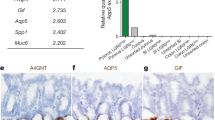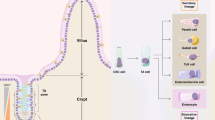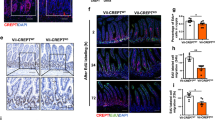Abstract
There is great interest in tumor stem cells (TSCs) as potential therapeutic targets; however, cancer therapies targeting TSCs are limited. A drawback is that TSC markers are often shared by normal stem cells (NSCs)1,2,3,4; thus, therapies that target these markers may cause severe injury to normal tissues. To identify a potential TSC-specific marker, we focused on doublecortin-like kinase 1 (Dclk1). Dclk1 was reported as a candidate NSC marker in the gut5,6, but recent reports have implicated it as a marker of differentiated cells (for example, Tuft cells)7,8. Using lineage-tracing experiments, we show here that Dclk1 does not mark NSCs in the intestine but instead marks TSCs that continuously produce tumor progeny in the polyps of ApcMin/+ mice. Specific ablation of Dclk1-positive TSCs resulted in a marked regression of polyps without apparent damage to the normal intestine. Our data suggest the potential for developing a therapy for colorectal cancer based on targeting Dclk1-positive TSCs.
This is a preview of subscription content, access via your institution
Access options
Subscribe to this journal
Receive 12 print issues and online access
$209.00 per year
only $17.42 per issue
Buy this article
- Purchase on SpringerLink
- Instant access to full article PDF
Prices may be subject to local taxes which are calculated during checkout






Similar content being viewed by others
References
Dalerba, P. et al. Phenotypic characterization of human colorectal cancer stem cells. Proc. Natl. Acad. Sci. USA 104, 10158–10163 (2007).
O'Brien, C.A., Pollett, A., Gallinger, S. & Dick, J.E. A human colon cancer cell capable of initiating tumour growth in immunodeficient mice. Nature 445, 106–110 (2007).
Zhu, L. et al. Prominin 1 marks intestinal stem cells that are susceptible to neoplastic transformation. Nature 457, 603–607 (2009).
Todaro, M., Francipane, M.G., Medema, J.P. & Stassi, G. Colon cancer stem cells: promise of targeted therapy. Gastroenterology 138, 2151–2162 (2010).
Giannakis, M. et al. Molecular properties of adult mouse gastric and intestinal epithelial progenitors in their niches. J. Biol. Chem. 281, 11292–11300 (2006).
May, R. et al. Identification of a novel putative gastrointestinal stem cell and adenoma stem cell marker, doublecortin and CaM kinase-like-1, following radiation injury and in adenomatous polyposis coli/multiple intestinal neoplasia mice. Stem Cells 26, 630–637 (2008).
Gerbe, F., Brulin, B., Makrini, L., Legraverend, C. & Jay, P. DCAMKL-1 expression identifies Tuft cells rather than stem cells in the adult mouse intestinal epithelium. Gastroenterology 137, 2179–2180 (2009).
Saqui-Salces, M. et al. Gastric tuft cells express DCLK1 and are expanded in hyperplasia. Histochem. Cell Biol. 136, 191–204 (2011).
Barker, N. et al. Identification of stem cells in small intestine and colon by marker gene Lgr5. Nature 449, 1003–1007 (2007).
Sangiorgi, E. & Capecchi, M.R. Bmi1 is expressed in vivo in intestinal stem cells. Nat. Genet. 40, 915–920 (2008).
Bonnet, D. & Dick, J.E. Human acute myeloid leukemia is organized as a hierarchy that originates from a primitive hematopoietic cell. Nat. Med. 3, 730–737 (1997).
Al-Hajj, M., Wicha, M.S., Benito-Hernandez, A., Morrison, S.J. & Clarke, M.F. Prospective identification of tumorigenic breast cancer cells. Proc. Natl. Acad. Sci. USA 100, 3983–3988 (2003).
Singh, S.K. et al. Identification of a cancer stem cell in human brain tumors. Cancer Res. 63, 5821–5828 (2003).
Li, C. et al. Identification of pancreatic cancer stem cells. Cancer Res. 67, 1030–1037 (2007).
Ricci-Vitiani, L. et al. Identification and expansion of human colon-cancer-initiating cells. Nature 445, 111–115 (2007).
Cocciadiferro, L. et al. Profiling cancer stem cells in androgen-responsive and refractory human prostate tumor cell lines. Ann. NY Acad. Sci. 1155, 257–262 (2009).
Clevers, H. The cancer stem cell: premises, promises and challenges. Nat. Med. 17, 313–319 (2011).
Davies, E.J., Marsh, V. & Clarke, A.R. Origin and maintenance of the intestinal cancer stem cell. Mol. Carcinog. 50, 254–263 (2011).
May, R. et al. Doublecortin and CaM kinase-like-1 and leucine-rich-repeat–containing G-protein–coupled receptor mark quiescent and cycling intestinal stem cells, respectively. Stem Cells 27, 2571–2579 (2009).
Gerbe, F. et al. Distinct ATOH1 and Neurog3 requirements define tuft cells as a new secretory cell type in the intestinal epithelium. J. Cell Biol. 192, 767–780 (2011).
Koizumi, H., Tanaka, T. & Gleeson, J.G. Doublecortin-like kinase functions with doublecortin to mediate fiber tract decussation and neuronal migration. Neuron 49, 55–66 (2006).
Sauer, B. & Henderson, N. Targeted insertion of exogenous DNA into the eukaryotic genome by the Cre recombinase. New Biol. 2, 441–449 (1990).
Soriano, P. Generalized lacZ expression with the ROSA26 Cre reporter strain. Nat. Genet. 21, 70–71 (1999).
Vermeulen, L. et al. Single-cell cloning of colon cancer stem cells reveals a multi-lineage differentiation capacity. Proc. Natl. Acad. Sci. USA 105, 13427–13432 (2008).
Verissimo, C.S. et al. Silencing of the microtubule-associated proteins doublecortin-like and doublecortin-like kinase-long induces apoptosis in neuroblastoma cells. Endocr. Relat. Cancer 17, 399–414 (2010).
Harada, N. et al. Intestinal polyposis in mice with a dominant stable mutation of the β-catenin gene. EMBO J. 18, 5931–5942 (1999).
Barker, N. et al. Crypt stem cells as the cells-of-origin of intestinal cancer. Nature 457, 608–611 (2009).
Visvader, J.E. & Lindeman, G.J. Cancer stem cells in solid tumours: accumulating evidence and unresolved questions. Nat. Rev. Cancer 8, 755–768 (2008).
Graham, S.M. et al. Primitive, quiescent, Philadelphia-positive stem cells from patients with chronic myeloid leukemia are insensitive to STI571 in vitro. Blood 99, 319–325 (2002).
Saito, M. et al. Diphtheria toxin receptor–mediated conditional and targeted cell ablation in transgenic mice. Nat. Biotechnol. 19, 746–750 (2001).
Buch, T. et al. A Cre-inducible diphtheria toxin receptor mediates cell lineage ablation after toxin administration. Nat. Methods 2, 419–426 (2005).
Merlos-Suárez, A. et al. The intestinal stem cell signature identifies colorectal cancer stem cells and predicts disease relapse. Cell Stem Cell 8, 511–524 (2011).
Acknowledgements
We thank K. Kohno (Nara Institute of Science and Technology) for kindly providing diphtheria toxin. We also thank Y. Kimura, S. Ishizu, M. Nakatsuji, R. Akitake-Kawano, K. Furuyama and T.S. Stappenbeck for technical assistance and helpful suggestions. This work was supported by the Japan Society for the Promotion of Science (JSPS) KAKENHI 10J02434, 21229009, 23590937, 24229005, 24659363, 24590914 and 24590916; the Research Program of the Project for Development of Innovative Research on Cancer Therapeutics (P-Direct) from the Ministry of Education, Culture, Sports, Science and Technology of Japan; Health and Labour Sciences Research Grants for Research on Intractable Diseases, Hepatitis, and Innovative Development and Practical Application of New Drugs for Hepatitis B from the Ministry of Health, Labour and Welfare, Japan; the Funding Program for Next-Generation World-leading Researchers (LS075) and Grants-in Aid from the Ministry of Education, Culture, Science, Sports and Technology of Japan; and the Princess Takamatsu Cancer Research Fund 10-24212.
Author information
Authors and Affiliations
Contributions
Y.N. and H.S. designed the study. Y.N., H.S., A.F., T.U., T.M., N.N. and K. Kanda performed the experiments. Y.N., H.S. and A.I. analyzed the data. Y.N., H.S., Y.K. and T.C. prepared the manuscript with input from the other authors. K. Kawada, Y.S., M.Y. and M.M.T. provided essential materials. Y.Y., H.K. and M.K. provided technical support and discussion. M.Y., R.K., Y.K., M.M.T., S.Y. and T.C. supervised the project.
Corresponding author
Ethics declarations
Competing interests
The authors declare no competing financial interests.
Supplementary information
Supplementary Text and Figures
Supplementary Figures 1–16 and Supplementary Table 1 (PDF 3157 kb)
Rights and permissions
About this article
Cite this article
Nakanishi, Y., Seno, H., Fukuoka, A. et al. Dclk1 distinguishes between tumor and normal stem cells in the intestine. Nat Genet 45, 98–103 (2013). https://doi.org/10.1038/ng.2481
Received:
Accepted:
Published:
Issue Date:
DOI: https://doi.org/10.1038/ng.2481



